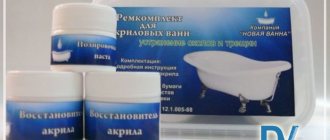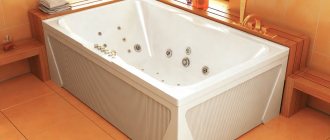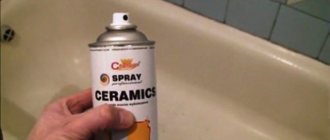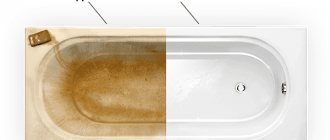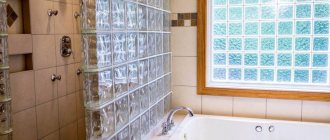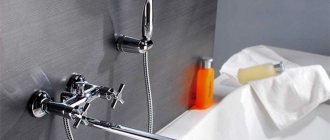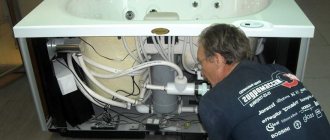Poor water quality and long-term use cause rust stains, cracks and chips to appear on the surface of the bathroom. To completely replace a bathtub will require a lot of time and additional financial losses. The old product will have to be dismantled, and this is not always possible or advisable. Often, after dismantling the bathtub, it is necessary to carry out complex construction work to restore the previous appearance of the room.
Old bath
Why is it beneficial to fill a bathtub with acrylic without dismantling it?
| Name of the breakdown | Cause and solutions |
| Damage to the lining around the bathtub | The bathroom walls are decorated with ceramic tiles, plastic panels, artificial stone and other modern expensive coatings. When removing the bathtub, they are necessarily damaged at the joints. It will not be possible to find materials of the same quality and appearance in the store; too much time has passed since their purchase. You will have to purchase finishing materials for the entire wall area or come up with various decorative inserts around the perimeter of the bathtub rim. Both the first and second options require quite a lot of money and time. |
| Drain and overflow problems | It is especially difficult to dismantle bathtubs in old buildings; all communications in them are made of cast iron pipes. In addition to the fact that there will be big problems with removal, you will have to solve the issue of connecting new systems. This is long and expensive and often requires the involvement of professional specialists. You will have to purchase additional plastic pipes, adapters, etc. |
| Large amounts of construction waste and dust | Completely replacing a bathtub means a lot of construction debris, dust and noise. It is difficult to live in an apartment during such work; you will have to look for temporary housing. |
| Long period of time | Replacement will require a minimum of two to three days. To fill a bathtub with acrylic, you need several hours for direct repair work, plus time for the material to harden. Can be done within a day. |
Even a cursory comparison of various bathtub repair technologies leaves no doubt which one to give preference to.
Restoration of bathtubs with acrylic - quick restoration of the surface
What is liquid acrylic for a bath
Liquid acrylic for baths
Stakryl - liquid for restoration
A two-component substance made from acrylates (esters) and hardeners. Acrylates are polymerized in special installations into polyacrylates and are colorless and odorless. Mineral dyes are added to give them a white color. For the production of liquid acrylics, butyl acrylates, the safest substances, are most often used. Sanitary control authorities have approved acrylic coatings for use in all premises without exception.
During mixing with the hardener, chemical reactions begin to occur, as a result of which new solid intermolecular bonds are formed. Strictly speaking, liquid acrylic for a bath is a particularly resistant polymer paint and has nothing to do with enamel. Comparing its physical properties with enamel coatings is a common but effective advertising trick by manufacturers. All polymeric substances and epoxy resins cannot be considered absolutely harmless to the human body. Coating surfaces with liquid acrylic is not enameling, but painting; this knowledge is needed to understand the technology of production.
Self-leveling acrylic
Important. Never use products from unknown manufacturers, they do not pass mandatory tests by government regulatory organizations and may cause skin irritation or deeper damage. In addition, such coatings do not have sufficient adhesion to the surface of the bathtub; after just a few months of intensive use, they will begin to peel off. And one last thing. In terms of hardness and resistance to mechanical loads, they are significantly inferior to products from licensed enterprises. Buyers are tempted by the low price of counterfeits, but the desire to save money by using low-quality materials most often leads to a double increase in costs. And this is at best; sometimes the consequences can be very sad.
liquid acrylic for bath
Coating service life
The acrylic coating has good strength and stability; cracks and scratches rarely form on it. But still, like any plumbing fixtures, careful care is required. First of all, you should avoid hitting the acrylic surface with heavy objects, otherwise serious damage will occur that is unlikely to be repaired. After taking a bath, it is recommended to immediately remove dirt from the surface and wipe it dry. Severe contamination requires the use of abrasives, and they are contraindicated for acrylic bathtubs. For cleaning, it is better to use a regular gel dishwashing detergent. Also, soaking laundry with bleaches or dyes is best done in a basin rather than in a bathtub.
How to fill bathtubs with plastic inserts with acrylic
Plastic liners are used for quick repairs of bathtub surfaces. They are bought by size and simply inserted into them with glue. Advantages: minimal loss of time for repairs. Disadvantages - plastic liners peel off from surfaces and crack. Water gets into the free space, an unpleasant odor appears, fungi multiply, etc. Those who have already used plastic liners no longer have the desire to repeat their mistakes. An excellent alternative to liners is filling the bathtub with acrylic. But to do this, you first need to remove the old liner; this is not so easy to do. How to get it out with minimal damage to the surface?
Step 1. Review the state of the element. Pay attention to ways to seal the space between the wall and the bathtub. Most often, the detachment of the liner occurs at the bottom, where there are greater loads and an increased likelihood of water getting into the cracks.
Step 2. Remove the decorative element of the overflow hole. Do not turn off the drain yet; water trapped under the liner will flow through it.
Step 3. Remove the waterproofing between the bathtub edge and the wall. If the edging is made with a ceramic belt, carefully remove it. To do this, you need to pry up one edge with a sharp, hard tool, carefully increase the chipping force, and do not allow damage to the materials. If a plastic-based sealant is used, the work is simplified. The sealant can be removed with a knife or screwdriver; small residues can be scraped off or sanded. The seal must be removed; it holds the side of the liner in place.
Step 4. Prepare a grinder with a thin cutting disc. The most difficult work begins - cutting the plastic liner into small segments.
Acrylic liner. Dismantling
Important. Do not cut through the plastic all the way; you may damage the enamel coating. Make only grooves a few millimeters deep. It is difficult to regulate the cutting depth; you need to have extensive experience working with an angle grinder. First, tap the surface; there will be a dull sound in the areas of peeling. Start working with them. This way you will not only prevent damage to the enamel, but also find out the thickness of the insert.
During cutting, a through hole is sure to form in some place. Start removing the insert from there.
Step 5. Insert a screwdriver into the gap between the tub and the insert and carefully pry it up. The plastic will begin to crack along the cut lines, insert the screwdriver deeper and move it along the cracks. The hole has become wider - use a chisel or other tool with increased dimensions. Continue shooting each segment one at a time. If some areas are firmly glued and do not come off, no problem. Let the plastic break off around them, remove those parts that do not create great difficulties.
Removing the liner
Step 6. Only firmly glued pieces of plastic remain on the surface. Place a chisel at the contact point and lightly tap it with a hammer to remove them. Shallow scratches on the enamel or small pieces of an unremoved plastic insert are not critical; they will either be sanded off when cleaning the surface with sandpaper or simply covered with liquid acrylic.
Next, you need to follow the algorithm described above - clean the surface from dirt and calcium deposits, degrease, dry and cover with liquid acrylic for the bath.
Surface cleaning
Degreasing the bath
Pour acrylic onto the sides
Continue pouring
The bath can be used after 36 hours
About safety precautions
If you plan to cover a bathtub with acrylic at home, follow these safety precautions:
- Carry out the work in thick clothes, without hanging ends, let them be taken from household items.
- Shoes must be closed type. For example, operations in shale are not recommended.
- A hat, protective screen and rubber gloves must be used during the work.
- The hand tool must have a handle firmly attached to the base.
- Before using the grinder, you should check the integrity of the wires and the presence of cracks, chips and other defects in the abrasive wheel.
How to make a color fill
White bath color is considered universal, but everyone has their own preferences. Green ones look original, water seems warmer in yellow ones, etc. We will not touch on design issues, this is not our topic. Let’s just consider what methods can be used to make liquid acrylic for a bathtub colored.
Mixing base and color
There is nothing complicated. We sell a wide range of special additives in various colors. They do not affect the quality of the coating; the surface remains as durable and smooth. Buy the color you want and make the coating original. Saturation depends on the amount of dye. Only one condition must be observed - the additive is diluted in the main component before adding the hardener, and not vice versa. All components must be mixed very thoroughly.
Colored bathtub, restoration of bathtubs with liquid acrylic
Features of application
Before purchasing acrylic, you should follow some rules.
If the hardener has a dark tint (red to brown), then the solution will have an unpleasant color. The shade of the product will be corrected by special pastes of the same brand. The color is determined in the room in the usual lighting or according to the interior. Pastel shades are most suitable for a bath; they do not change color over time. While bright shades can sometimes change their original color.
Important! The amount of dye should not exceed three percent of the total composition in order to maintain the technical characteristics of the product.
You should not purchase a product with a short period of time until it completely hardens. Practice shows that a coating that has a long drying time lasts longer. The restoration itself should not be carried out for more than four hours; work should not be interrupted or stopped for a long time. Experienced specialists complete the work within a few hours. Beginners should also apply quickly and carefully.
Before restoration, the bathtub is specially prepared.
For cleaning you need to prepare:
1.sandpaper.
2.brush.
3.soda or other cleaning agent.
4.spatula with rubber gloves.
The hole for draining water and the overflow area are freed from the linings. The bathtub is cleaned with sandpaper and washed with a degreaser. Cracks and chips are repaired using automotive putty. Then they clean and wash again.
Before application, be sure to warm up the bath by pouring hot water into it for fifteen minutes. Next, the liquid is drained and the bath is dried using a hair dryer.
Defects and ways to eliminate them
Unfortunately, they can occur in inexperienced craftsmen. Eliminating some will require a minimum of time, while others will require a complete refill of the bath. Sometimes it will be necessary to first remove the defective one. In this regard, we never tire of reminding you that it is easier to prevent all problems than to eliminate them later.
Bathroom restoration without mistakes
| Defect detected | Supposed causes of the defect | Remedies |
| Liquid acrylic slowly flows down vertical surfaces, the coating layer is too thick, and overuse of material is possible. | Viscosity too high. May result from prolonged or improper storage conditions. | Add xylene thinner. Add carefully, pour in portions with constant stirring. The consistency is determined by eye; for this you need to have practical experience. The area where the acrylic is laid down in a thick layer needs to be smeared with a spatula or brush, and then refilled. |
| On the surface there are types of joints between fills. | Gross violations of recommended technology. Several factors may be present at the same time: high temperature, long pouring process, too viscous material. | Refill required. You can use more liquid acrylic, this will reduce the amount of material while maintaining high quality coating. |
| After hardening, soft areas remained on the surface. | The ingredients are not mixed well. | You will have to remove soft areas and carry out repair work. Keep in mind that patch marks will always be visible. If not immediately, then after a short period of use they will definitely show up. The defective coating should be removed and a new one should be poured. |
| When it hardens, the surface of the coating wrinkles. | The percentage of hardener was violated, the temperature regime was not observed, and poor-quality mixing. | Requires a complete refill. The defective layer is first removed. Carry out all technological operations carefully. |
| Some areas began to peel off. | There are greasy stains on the surface of the bathtub. | You can try to repair problem areas, but it is better to immediately refill the bathtub. |
| There are yellow spots on the surface, and the hardness is good. | Ingredients are not mixed well. | You can try sanding and polishing these areas first. If the yellow spots have not disappeared, you will have to refill the entire surface. |
| Lumps and small roughness are visible on the surface. | The surface of the bathtub was poorly cleaned of solid particles; the work was carried out in a dusty room. | If the particles are small, they can be ground and polished. If after these steps the surface is not leveled, refill the bath. |
Possible mistakes
Since the process of painting the bathtub is planned to be done on your own without experience, there is a high probability of making many mistakes. To avoid them, it is necessary to study the most frequently occurring problems in advance. Popular mistakes include:
- improper preparation of plumbing products, as well as a complete lack of preparatory work;
- use of low quality material;
- Often, after pouring paint, people do not pay much attention to drips, although they must be removed within 15 minutes, otherwise it will not be possible to correct the defects later;
- the work is carried out in a closed room, which can cause human poisoning;
- using the room for different purposes immediately after creating a new coating, which certainly leads to dust settling on the new enamel, so after hardening it will not be snow-white and perfect;
- Uneven distribution of enamel or acrylic leads to the fact that the coating is slightly crooked, so the bathtub looks unattractive.
Thus, discovering rust stains or other unsightly elements on an old bathtub is not always a reason to purchase a new plumbing fixture. Updating it is considered a fairly simple job, for which various means can be used. The most common choices are liquid acrylic or special enamels. They are easy to work with, so with minimal money and effort a new, high-quality and even coating is created. If you do the work correctly, taking into account the basic rules and sequence of actions, as well as remembering the most common mistakes, then the new coating will last a long time.
Practical advice
Never try to speed up the hardening of acrylic by ventilating the premises. Firstly, the material does not dry out, but hardens as a result of chemical reactions. Secondly, the longer the hardening process takes place, the better the quality of the coating. In this regard, it is not recommended to use quick-setting compounds. Thirdly, drafts can cause dust to enter the surface, and this is a very big problem. Fourthly, chemical compounds will get into all rooms, and this should not be allowed.
If you do not have a special device for mixing the components, then you can make it yourself. Moreover, it will work no worse, but better than the factory one. The fact is that the design features of the factory mixer provide for capturing liquid from the surface and directing it to the bottom. During this process, bubbles appear - an extremely negative consequence. The bubbles will then have to be removed. You can make a primitive stirrer from a piece of straight wire with a diameter of approximately 4 mm. Bend one end into a P shape, insert the other straight end into the cartridge and feel free to use a stirrer. Even such a primitive device is much more effective than manual mixing of components.
Do-it-yourself construction mixer from a screwdriver or drill using scrap materials
Never use mixture that remains near the sides of the container. In these places, mixing is always insufficient; acrylic has little hardener. As a result, soft areas will appear and will have to be removed and repaired or completely refilled. Don’t be afraid that there may not be enough mixture; the manufacturer provides a reserve volume. If for some reason it is not enough, then you can remove a little from the bottom with a rubber spatula and apply it to the right place. The thickness of the layer at the bottom always allows this to be done.
The better the surface is prepared, degreased and cleaned, the better the coating. Take your time, use all measures to prepare the surface of the bathtub for coating with liquid acrylic.
If you have any material left, do not expect that you will be able to save it for repair work. No matter how tightly the container is closed, chemical reactions cannot be stopped; the liquid will thicken in any case.
Liquid acrylic for bathtubs has good performance indicators, it’s true. But it is also true that it is much inferior in quality to enamel. Conclusion - use the bathroom carefully, do not allow heavy loads, protect from impacts and other mechanical damage. When cleaning, use only approved detergents.
Use the bathtub carefully
Detected drips are much easier to clean up immediately. Use clean rags or paper for this. Wipe off marks thoroughly and do not leave white streaks. You can’t wash it off with anything; work only with dry rags. It is advisable to work with gloves; acrylic that gets on your hands is difficult to remove. In addition, it may cause allergic reactions in some people.
If possible, dismantle the old bathtub completely. This will greatly facilitate the filling work, and it will be possible to ensure high-quality control of the coating and timely elimination of detected problems. There is no way to remove the bathtub - treat all technological operations very responsibly. Learn how to install a heated towel rail in the bathroom yourself using the link.
Further care
Acrylic is softer than enamel and therefore requires special care. Do not use abrasives or metal sponges for cleaning. A soft sponge and dish soap are ideal. There are specialized products for caring for acrylic surfaces on sale.
To avoid damaging the surface made of liquid acrylic when bathing pets, you need to lay a rubber mat on the bottom.
If you strictly follow the instructions, even a non-professional can perform a high-quality restoration of a bathtub with acrylic. Experts involved in renovation of structures advise not to be afraid of increased acrylic consumption. There is always enough of it, since a layer of about 2 cm accumulates at the bottom.
Final works
The paste hardens for quite a long time. On average, pre-polymerization ends after 48 hours. During this time, it is better not to approach the bowl. Otherwise, dust particles and fluff raised in the air will stick. Sometimes at this moment they notice minor defects and try to correct them, which is strictly prohibited. A weak paste will not allow you to do this; it will only make things worse. You will have to wait until it hardens before using the repair kit.
How long the surface will dry after repair is specified on the product packaging. After waiting the required time, they put the harness in place. If necessary, replace the gaskets and lubricate them with sealant. Remove the plastic from the tap and replace the shower head. The job has been successfully completed. In conclusion, we suggest watching a video detailing the process of painting a bathtub with acrylic.
How to clean a bathtub without damaging the enamel?
Use products specifically designed for this purpose to regularly clean enamel surfaces. As an alternative, you can use household chemicals that do not contain abrasive particles and do not contain strong solvents. When cleaning enamel bathtubs, use a soft sponge or rag.

